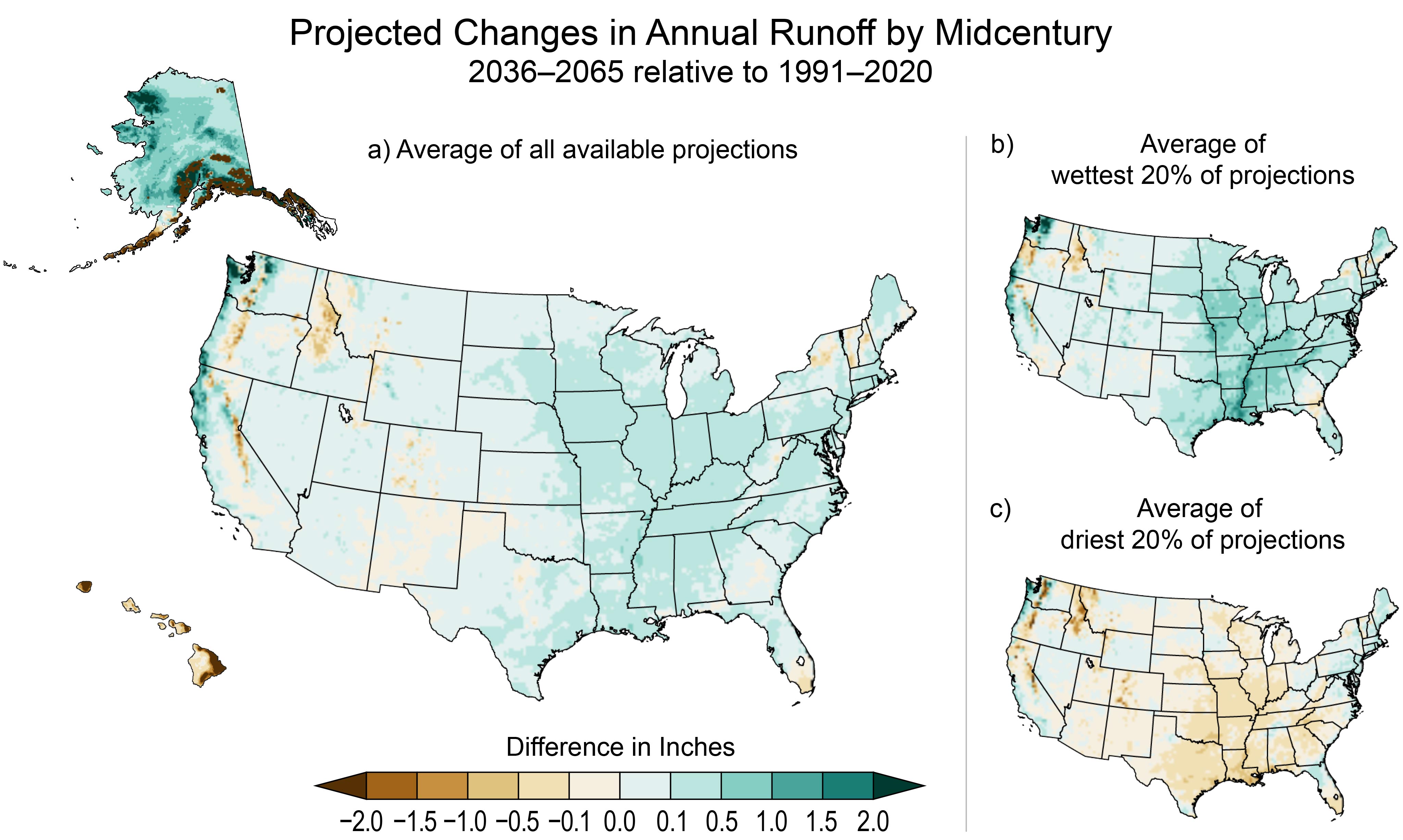According to the NCA5, Wyoming is part of the Northern Great Plains region.
Here are applicable Key Messages for the Northern Great Plains related to Water, Precipitation, and Drought.
Key: blue highlight = historical trends, yellow highlight = projected trends, and green highlight = both historical and projected trends.
Summary
The Northern Great Plains (NGP) consists of three primary regions - mountainous west, semiarid high plains, and humid eastern plains - that may respond to changes in climate differently (11). Since 1900, the annual average temperature in the NGP has increased by 1.6-2.6 degrees F, with the most pronounced changes occurring in the winter; Wyoming in particular has seen an increase in warm nights, while the entire region has seen a decrease in very cold days (12). This will have a few key impacts:
- The timing and form of precipitation is changing, with the number of days "favorable to significant hail" increasing by 2-4 days per year (12). Increases in heavy precipitation events will also increase annual runoff (2).

“Annual precipitation projections show large regional differences and a wide range of potential differences” (1)
Figure 4.3: "Under an intermediate (RCP4.5) scenario, annual precipitation is projected to increase for much of the US (a), except for the Southwest, Hawai'i, and the US Caribbean (not shown; see Figure 23.2, which shows rainfall reductions of about 10% by midcentury, and increases in dry days during the wet season, for Puerto Rico). The wettest and driest 20% of projections (b, c) illustrate the range of uncertainty in annual precipitation projections. This figure shows projected changes in inches. In the Southwest, a half-inch change in annual precipitation has more influence on the region's hydrology than does a half-inch change in the Northeast (see Figure 2.10 for percent changes under different warming levels). Projections are not available for the US-Affiliated Pacific Islands. Figure credit: University of Colorado Boulder, NOAA NCEI, and CISESS NC" (1).
- Decreasing snowpack will affect both surface water availability and groundwater resources, increasing pressure on water resources (12).
- A decrease in peak streamflow has been observed in Wyoming, which is a proxy for flooding; this may reduce pressure from floods, but comes with increased pressure from aridity and increased temperatures (12). Localized droughts are projected to increase by 2040 and widespread regional droughts are projected to increase by 2070 (12).
- Reduced flows in the Colorado River Basin will occur due to warming, although floods and increased runoff are possible in certain locations (12). Climate effects on watersheds will be amplified by both "gradual and episodic" stressors (9).

“Projected changes in runoff vary across the Nation due to projected changes in multiple aspects of the water cycle” (1)
Figure 4.7: "Rivers and streams aggregate runoff across watersheds, and runoff integrates climate change impacts to the water cycle (Figures 4.3, 4.4, 4.5, 4.6); as a result, impacts to runoff over a watershed are commonly used as surrogates for impacts to streamflow. Under an intermediate scenario (RCP4.5), projections of annual runoff vary geographically depending on relative changes to precipitation, evapotranspiration, snow and ice, groundwater, and soil moisture. Decreases are projected in Hawai'i and parts of the Nation supplied by snow (a). Projections are not available for US-Affiliated Pacific Islands or the US Caribbean; however, given projected decreases in precipitation and increases in temperature in the Caribbean, annual runoff is expected to decrease. The range between the wettest (b) and driest (c) projections illustrate the uncertainty in runoff projections. Figure credit: University of Colorado Boulder, NOAA NCEI, and CISESS NC" (1).
- Soil moisture may increase in southwestern Wyoming, contrary to the rest of the NGP region (12).
- Water quality will also be impacted; excess nutrient flow from agricultural and industrial runoff is "expected to be exacerbated by climate change" (13).

“Climate change threatens the quality of freshwater supplies” (3)
Figure 4.2: "Changes in ambient temperature, sea level, and rainfall (top) can create climate-related hazards, such as changes in water temperature and saltwater intrusion (middle) that can have negative impacts on water quality (bottom). Saltwater intrusion is an imminent threat to coastal and island communities dependent on groundwater for dinking water (KMs 30.1, 9.2); agricultural areas face risks to water supplies when fertilizers and pesticides are mobilized by flooding; higher temperatures are putting many areas at risk of exposure to harmful algal blooms (e.g., KM 22.2) and increases in fecal coliform bacteria; and treatment plants are challenged by sediments and debris from wildfires in their source waters (KM 6.1). Adapted from Nijhawan and Howard 2022 [CC BY 4.0]" (3).
- Forest water resources are frequently tied to extreme events, such as floods, droughts, and wildfire; following fires, water quality severely decreases as runoff of sediments, metals, and other potential pollutants are discharged into downstream water sources (6, 7). Warming and changes in precipitation affect wildlife, forest ecosystems, and water availability (7).
- Disproportionate impacts on water resources will be felt by Tribal and rural communities, depending on "economic sector, access to water resources, ability to irrigate, reliance on electricity, and socioeconomic status" (3, 4).
How are communities addressing these changes?
- Communities in the NGP have improved monitoring systems to make more informed water management decisions (15).
- The US Army Corps of Engineers, in collaboration with state climate offices, is forming a soil moisture and snowpack monitoring network to increase data availability (15).
- The Upper Colorado River Commission (UCRC) may implement a demand-management program in some NGP states that would compensate users for voluntarily reducing water consumption (15). The excess water would be "stored in federal reservoirs and released [elsewhere] when needed" (15).
- Watershed and irrigation groups are considering collaborative strategies to share water management and manage water resources for a variety of needs (15).
- Nature-based solutions (NBSs), or “ecosystem-based mitigation and adaptation opportunities,” are another pathway for adapting management practices to climate change; when NBSs are “managed in collaboration with affected communities and… local knowledge,” these can be effective solutions for addressing multiple management goals in an inclusive, cost-effective method (10). Ecosystem-based adaptations, a type of NBS, have been used in solutions such as “protecting and restoring floodplains to help reduce flood impacts or helping farmers cope with drought through soil conservation measures” (10).
- Trade-offs will be necessary as climate change affects available water resources; for example, communities in the Northern Great Plains will need to move towards “water-conservative and nutrient-retentive land cover” (14).
Payton, E.A., A.O. Pinson, T. Asefa, L.E. Condon, L.-A.L. Dupigny-Giroux, B.L. Harding, J. Kiang, D.H. Lee, S.A. McAfee, J.M. Pflug, I. Rangwala, H.J. Tanana, and D.B. Wright, 2023: Ch. 4. Water. In: Fifth National Climate Assessment. Crimmins, A.R., C.W. Avery, D.R. Easterling, K.E. Kunkel, B.C. Stewart, and T.K. Maycock, Eds. U.S. Global Change Research Program, Washington, DC, USA. https://doi.org/10.7930/NCA5.2023.CH4. PDF.
Payton, E.A., A.O. Pinson, T. Asefa, L.E. Condon, L.-A.L. Dupigny-Giroux, B.L. Harding, J. Kiang, D.H. Lee, S.A. McAfee, J.M. Pflug, I. Rangwala, H.J. Tanana, and D.B. Wright, 2023: Ch. 4. Water: Key Message 1. In: Fifth National Climate Assessment. Crimmins, A.R., C.W. Avery, D.R. Easterling, K.E. Kunkel, B.C. Stewart, and T.K. Maycock, Eds. U.S. Global Change Research Program, Washington, DC, USA. https://doi.org/10.7930/NCA5.2023.CH4. PDF.
Payton, E.A., A.O. Pinson, T. Asefa, L.E. Condon, L.-A.L. Dupigny-Giroux, B.L. Harding, J. Kiang, D.H. Lee, S.A. McAfee, J.M. Pflug, I. Rangwala, H.J. Tanana, and D.B. Wright, 2023: Ch. 4. Water: Key Message 2. In: Fifth National Climate Assessment. Crimmins, A.R., C.W. Avery, D.R. Easterling, K.E. Kunkel, B.C. Stewart, and T.K. Maycock, Eds. U.S. Global Change Research Program, Washington, DC, USA. https://doi.org/10.7930/NCA5.2023.CH4. PDF.
Payton, E.A., A.O. Pinson, T. Asefa, L.E. Condon, L.-A.L. Dupigny-Giroux, B.L. Harding, J. Kiang, D.H. Lee, S.A. McAfee, J.M. Pflug, I. Rangwala, H.J. Tanana, and D.B. Wright, 2023: Ch. 4. Water: Key Message 3. In: Fifth National Climate Assessment. Crimmins, A.R., C.W. Avery, D.R. Easterling, K.E. Kunkel, B.C. Stewart, and T.K. Maycock, Eds. U.S. Global Change Research Program, Washington, DC, USA. https://doi.org/10.7930/NCA5.2023.CH4. PDF.
Domke, G.M., C.J. Fettig, A.S. Marsh, M. Baumflek, W.A. Gould, J.E. Halofsky, L.A. Joyce, S.D. LeDuc, D.H. Levinson, J.S. Littell, C.F. Miniat, M.H. Mockrin, D.L. Peterson, J. Prestemon, B.M. Sleeter, and C. Swanston, 2023: Ch. 7. Forests. In: Fifth National Climate Assessment. Crimmins, A.R., C.W. Avery, D.R. Easterling, K.E. Kunkel, B.C. Stewart, and T.K. Maycock, Eds. U.S. Global Change Research Program, Washington, DC, USA. https://doi.org/10.7930/NCA5.2023.CH7. PDF.
Domke, G.M., C.J. Fettig, A.S. Marsh, M. Baumflek, W.A. Gould, J.E. Halofsky, L.A. Joyce, S.D. LeDuc, D.H. Levinson, J.S. Littell, C.F. Miniat, M.H. Mockrin, D.L. Peterson, J. Prestemon, B.M. Sleeter, and C. Swanston, 2023: Ch. 7. Forests: Key Message 1. In: Fifth National Climate Assessment. Crimmins, A.R., C.W. Avery, D.R. Easterling, K.E. Kunkel, B.C. Stewart, and T.K. Maycock, Eds. U.S. Global Change Research Program, Washington, DC, USA. https://doi.org/10.7930/NCA5.2023.CH7. PDF.
Domke, G.M., C.J. Fettig, A.S. Marsh, M. Baumflek, W.A. Gould, J.E. Halofsky, L.A. Joyce, S.D. LeDuc, D.H. Levinson, J.S. Littell, C.F. Miniat, M.H. Mockrin, D.L. Peterson, J. Prestemon, B.M. Sleeter, and C. Swanston, 2023: Ch. 7. Forests: Key Message 2. In: Fifth National Climate Assessment. Crimmins, A.R., C.W. Avery, D.R. Easterling, K.E. Kunkel, B.C. Stewart, and T.K. Maycock, Eds. U.S. Global Change Research Program, Washington, DC, USA. https://doi.org/10.7930/NCA5.2023.CH7. PDF.
McElwee, P.D., S.L. Carter, K.J.W. Hyde, J.M. West, K. Akamani, A.L. Babson, G. Bowser, J.B. Bradford, J.K. Costanza, T.M. Crimmins, S.C. Goslee, S.K. Hamilton, B. Helmuth, S. Hoagland, F.-A.E. Hoover, M.E. Hunsicker, R. Kashuba, S.A. Moore, R.C. Muñoz, G. Shrestha, M. Uriarte, and J.L. Wilkening, 2023: Ch. 8. Ecosystems, ecosystem services, and biodiversity. In: Fifth National Climate Assessment. Crimmins, A.R., C.W. Avery, D.R. Easterling, K.E. Kunkel, B.C. Stewart, and T.K. Maycock, Eds. U.S. Global Change Research Program, Washington, DC, USA. https://doi.org/10.7930/NCA5.2023.CH8. PDF.
McElwee, P.D., S.L. Carter, K.J.W. Hyde, J.M. West, K. Akamani, A.L. Babson, G. Bowser, J.B. Bradford, J.K. Costanza, T.M. Crimmins, S.C. Goslee, S.K. Hamilton, B. Helmuth, S. Hoagland, F.-A.E. Hoover, M.E. Hunsicker, R. Kashuba, S.A. Moore, R.C. Muñoz, G. Shrestha, M. Uriarte, and J.L. Wilkening, 2023: Ch. 8. Ecosystems, ecosystem services, and biodiversity: Key Message 1. In: Fifth National Climate Assessment. Crimmins, A.R., C.W. Avery, D.R. Easterling, K.E. Kunkel, B.C. Stewart, and T.K. Maycock, Eds. U.S. Global Change Research Program, Washington, DC, USA. https://doi.org/10.7930/NCA5.2023.CH8. PDF.
McElwee, P.D., S.L. Carter, K.J.W. Hyde, J.M. West, K. Akamani, A.L. Babson, G. Bowser, J.B. Bradford, J.K. Costanza, T.M. Crimmins, S.C. Goslee, S.K. Hamilton, B. Helmuth, S. Hoagland, F.-A.E. Hoover, M.E. Hunsicker, R. Kashuba, S.A. Moore, R.C. Muñoz, G. Shrestha, M. Uriarte, and J.L. Wilkening, 2023: Ch. 8. Ecosystems, ecosystem services, and biodiversity: Key Message 3. In: Fifth National Climate Assessment. Crimmins, A.R., C.W. Avery, D.R. Easterling, K.E. Kunkel, B.C. Stewart, and T.K. Maycock, Eds. U.S. Global Change Research Program, Washington, DC, USA. https://doi.org/10.7930/NCA5.2023.CH8. PDF.
Knapp, C.N., D.R. Kluck, G. Guntenspergen, M.A. Ahlering, N.M. Aimone, A. Bamzai-Dodson, A. Basche, R.G. Byron, O. Conroy-Ben, M.N. Haggerty, T.R. Haigh, C. Johnson, B. Mayes Boustead, N.D. Mueller, J.P. Ott, G.B. Paige, K.R. Ryberg, G.W. Schuurman, and S.G. Tangen, 2023: Ch. 25. Northern Great Plains. In: Fifth National Climate Assessment. Crimmins, A.R., C.W. Avery, D.R. Easterling, K.E. Kunkel, B.C. Stewart, and T.K. Maycock, Eds. U.S. Global Change Research Program, Washington, DC, USA. https://doi.org/10.7930/NCA5.2023.CH25. PDF.
Knapp, C.N., D.R. Kluck, G. Guntenspergen, M.A. Ahlering, N.M. Aimone, A. Bamzai-Dodson, A. Basche, R.G. Byron, O. Conroy-Ben, M.N. Haggerty, T.R. Haigh, C. Johnson, B. Mayes Boustead, N.D. Mueller, J.P. Ott, G.B. Paige, K.R. Ryberg, G.W. Schuurman, and S.G. Tangen, 2023: Ch. 25. Northern Great Plains: Key Message 1. In: Fifth National Climate Assessment. Crimmins, A.R., C.W. Avery, D.R. Easterling, K.E. Kunkel, B.C. Stewart, and T.K. Maycock, Eds. U.S. Global Change Research Program, Washington, DC, USA. https://doi.org/10.7930/NCA5.2023.CH25. PDF.
Knapp, C.N., D.R. Kluck, G. Guntenspergen, M.A. Ahlering, N.M. Aimone, A. Bamzai-Dodson, A. Basche, R.G. Byron, O. Conroy-Ben, M.N. Haggerty, T.R. Haigh, C. Johnson, B. Mayes Boustead, N.D. Mueller, J.P. Ott, G.B. Paige, K.R. Ryberg, G.W. Schuurman, and S.G. Tangen, 2023: Ch. 25. Northern Great Plains: Key Message 2. In: Fifth National Climate Assessment. Crimmins, A.R., C.W. Avery, D.R. Easterling, K.E. Kunkel, B.C. Stewart, and T.K. Maycock, Eds. U.S. Global Change Research Program, Washington, DC, USA. https://doi.org/10.7930/NCA5.2023.CH25. PDF.
Knapp, C.N., D.R. Kluck, G. Guntenspergen, M.A. Ahlering, N.M. Aimone, A. Bamzai-Dodson, A. Basche, R.G. Byron, O. Conroy-Ben, M.N. Haggerty, T.R. Haigh, C. Johnson, B. Mayes Boustead, N.D. Mueller, J.P. Ott, G.B. Paige, K.R. Ryberg, G.W. Schuurman, and S.G. Tangen, 2023: Ch. 25. Northern Great Plains: Key Message 4. In: Fifth National Climate Assessment. Crimmins, A.R., C.W. Avery, D.R. Easterling, K.E. Kunkel, B.C. Stewart, and T.K. Maycock, Eds. U.S. Global Change Research Program, Washington, DC, USA. https://doi.org/10.7930/NCA5.2023.CH25. PDF.
Knapp, C.N., D.R. Kluck, G. Guntenspergen, M.A. Ahlering, N.M. Aimone, A. Bamzai-Dodson, A. Basche, R.G. Byron, O. Conroy-Ben, M.N. Haggerty, T.R. Haigh, C. Johnson, B. Mayes Boustead, N.D. Mueller, J.P. Ott, G.B. Paige, K.R. Ryberg, G.W. Schuurman, and S.G. Tangen, 2023: Ch. 25. Northern Great Plains: Key Message 5. In: Fifth National Climate Assessment. Crimmins, A.R., C.W. Avery, D.R. Easterling, K.E. Kunkel, B.C. Stewart, and T.K. Maycock, Eds. U.S. Global Change Research Program, Washington, DC, USA. https://doi.org/10.7930/NCA5.2023.CH25. PDF.

